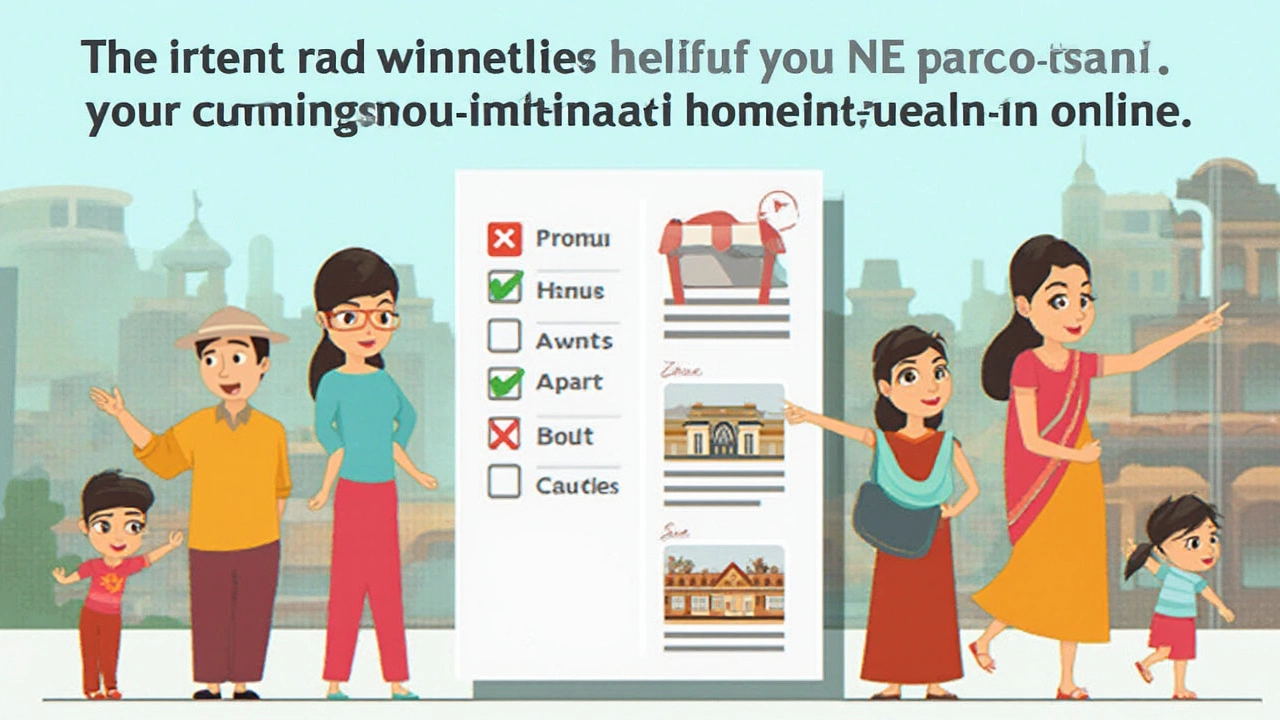Ever tried searching for rent-to-own homes and landed on a website that just felt sketchy? You're not alone, and here's the deal: some sites are legit, others... not so much. If you're tired of wasting evenings scrolling through old listings or straight-up scams, you need to know which sites are actually worth your time.
Rent-to-own might sound complicated, but the right website can make the process way easier. Imagine not having to hunt through endless rental ads or risk getting ghosted after handing over your info. With a few smart moves, you can zero in on the sites that actually have real, updated listings—plus the know-how to keep you from losing money or patience. Stick around for some concrete advice on where to start your search, how to spot shady offers, and the special features that really save your sanity.
- How Rent-to-Own Really Works
- Top Websites for Rent-to-Own Homes
- What Sets the Best Sites Apart
- Red Flags to Watch Out For
- Tips to Get the Most from Your Search
How Rent-to-Own Really Works
Let’s get straight to it—rent-to-own is basically a setup where you rent a place, but with the option to buy it later. Instead of locking in a big mortgage right away, you start out as a renter. The best part? A chunk of your monthly rent can actually go toward the purchase if you choose to buy.
So how does this play out in real life? Here's what usually happens:
- You find a house listed as rent-to-own—often highlighted on the better websites just for these kinds of deals.
- You and the owner agree on the basics: how long you’ll rent, the sale price, how much rent goes toward the purchase, and a deadline to decide.
- There’s usually an upfront fee, called the "option fee"—often 1% to 5% of the home price. Pay this, and you’ve got the right—but not the obligation—to buy later.
- Each month, a portion of your rent (like $200 on a $1,400 bill) gets set aside. It doesn’t always work this way, but it’s common with solid rent-to-own homes agreements.
- When the lease ends, you get to decide—buy at the pre-agreed price, or walk away. If you walk, you lose the extra money you paid, but you’re not locked in.
According to a 2023 report from the Urban Institute, about 7% of U.S. home transactions in certain markets used some form of rent-to-own. It’s way more common than most people think, especially for buyers needing time to save for a down payment or clean up their credit.
| Key Terms | What it Means |
|---|---|
| Option Fee | Upfront payment for the right to buy later |
| Rent Credit | Part of your rent that gets set aside for buying |
| Purchase Price | What you'll pay if you buy, set at the start |
| Lease Term | How long you rent before deciding |
If you’re using a rent-to-own homes website, these basics should be clearly explained in each property listing. Shady sites often skip these details, so always double-check. The good ones break down fees, credit, and deadlines upfront—no guessing games.
Top Websites for Rent-to-Own Homes
So where do you start if you want actual rent-to-own homes and not just another random internet rabbit hole? A few sites stand out for being current, easy to use, and not making you jump through hoops just to see listings.
- RentToOwnLabs.com: This site gets straight to the point. The search is simple, and real properties are listed with upfront pricing details. They offer filters for neighborhoods, price, and even how long a property has been on the market. You can usually get landlord contact info fast, which is a total time-saver.
- RentOwn.net: These guys focus entirely on rent-to-own listings. No hidden fees to view listings, and the database refreshes pretty much daily. They also explain the local market, so you can see whether you’re getting a good deal or just paying for a fancy zip code.
- Zillow: While Zillow isn’t a dedicated rent-to-own homes site, it’s honestly hard to beat their filters. There’s a "rent-to-own" checkbox, and while listings can be sparse in some areas, Zillow usually covers a wide net. Bonus: their map view lets you spot deals in up-and-coming neighborhoods.
- HomeFinder: This site is pretty straightforward. You can sort listings by property type and price, and their special "Rent to Own" tab gives a focused list so you’re not digging through unrelated rentals.
Now, some sites—like RentUntilYouOwn and HousingList—also pop up a lot. They often offer a free trial but remember, you’ll sometimes hit paywalls faster. If a site asks for credit card info before showing any listings, dig deeper first. Real talk: paying upfront doesn’t always get you the best rent-to-own homes. Sometimes it just means you’re paying for the privilege to browse.
| Website | Free Listings | Area Coverage | User Reviews |
|---|---|---|---|
| RentToOwnLabs.com | Yes | Nationwide | 4.7/5 |
| RentOwn.net | Yes | Nationwide | 4.5/5 |
| Zillow | Yes | Nationwide | 4.6/5 |
| HomeFinder | Yes | Mostly US cities | 4.3/5 |
Bottom line? Stick with these sites at the start of your search. The search tools actually work, and you won’t get buried under fake listings or outdated information. Always double-check the date on any ad—even big sites can let old stuff slip through—but these four are usually a safe bet if you want real rent-to-own homes options.

What Sets the Best Sites Apart
When you’re hunting for rent-to-own homes, the difference between an average website and the best one is huge. Real sites do more than just throw listings at you—they help you spot deals that work and give you solid info up front. Here’s what actually makes a site stand out when you jump into the world of rent-to-own listings.
First up, fresh and verified listings matter. The best websites update their databases every day, so you’re not messaging people who moved three months ago. Sites like Home Partners of America and Divvy score big points because they approve actual properties and regularly weed out fake or outdated info.
Transparency is another big deal. Quality sites list monthly prices, lease terms, and even the possible future purchase price. Check out OwnHome and RentOwn.net—they lay out the basics so you don’t have to squint at fine print or play guessing games with your monthly budget.
- Search filters: Easy-to-use filters are a game changer. You want to sort by price, location, or number of bedrooms in seconds, not scroll for ages.
- Photos and details: Reliable sites show lots of photos, floor plans, and even virtual tours, which help you spot red flags without ever leaving your couch.
- Lease agreement info: Sites like Divvy and Home Partners of America often share sample house rent agreement docs or outline what’s included, so you’re not left in the dark when it’s time to sign.
One more thing—real support and contact details count for a lot. If a site only offers a generic email form and you can’t talk to a real person, that’s a red flag. The best sites give you clear customer support channels and sometimes even live chat to walk you through your options.
| Website | Verified Listings | Sample Agreements | Direct Support |
|---|---|---|---|
| Home Partners of America | Yes | Yes | Phone, Email |
| Divvy | Yes | Yes | Live Chat, Email |
| RentOwn.net | Partial | No |
Long story short, the best rent-to-own websites work hard to give you solid leads, real info, and the support you actually need to make a good decision. Skip the sites with generic listings and go for ones that treat you like you’re there to get a home—not just click another ad.
Red Flags to Watch Out For
If you’re searching for rent-to-own homes online, you’ve got to keep your guard up. Not every website promising deals is trustworthy. A lot of scams pop up because they know people are desperate for a shot at homeownership. Here’s what you need to be careful about.
- Paywalls Before Information: If a site asks for a crazy high fee just to see basic details or photos, step back. The best rent-to-own homes websites will show you listings or at least sample properties for free. If you have to pay just to read addresses, that’s a warning sign.
- No Customer Support or Contact Details: Any site that hides its phone number, address, or doesn’t have real reviews is risky. Good websites have real customer service and actual humans you can contact.
- Old or Recycled Listings: A huge problem is listings that are months old or homes that aren’t actually available. If you see the same house on multiple sites, or the pictures look oddly generic, be cautious.
- Asking for Personal Details Upfront: If they need your Social Security number or bank account before you’ve seen a property or talked with anyone, don’t share it. Real providers will wait until you’re actually moving forward in the process.
- Big Promises, Little Proof: If a website promises guaranteed home approval or "100% move in for anyone" without checking your background or finances, that’s not real. There are always steps and paperwork with real house rent agreements.
The FTC has warned people about a rise in home rental scams, especially during the last few years. According to their data, reports about rental scams jumped by almost 30% from 2022 to 2023. And the fake websites are getting better at pretending to be legit—sometimes even using fake customer testimonials or made-up real estate agent names.
| Red Flag | What It Means |
|---|---|
| High fee before access | More likely a scam or low value |
| No phone/address | No real business behind the site |
| Generic or repeat listings | The home may not exist or be available |
| Upfront sensitive data request | High risk of ID theft |
| Instant approval offers | Not realistic for rent-to-own homes |
Don’t rush into anything because a listing looks perfect. Slow down and double-check the site’s reputation. It’s always worth googling the website’s name plus the word “scam” before you hand over cash or information. These small steps can save you from a massive headache later.

Tips to Get the Most from Your Search
Want to actually score a home through a rent-to-own homes website and not get lost in a sea of dead listings? You need a game plan. Here’s what actually moves the needle when you’re trolling through the top rent-to-own listings online.
- Use the filters. Most legit best website options come with search filters—set your budget, pick your city, and choose features like pet-friendly or number of bedrooms. Filters save you hours and cut the junk fast.
- Double-check listing dates and updates. If a home’s been listed for months but still hasn’t moved, there’s probably something wrong. Fresh listings usually get scooped up faster, so sort by “newest first.”
- Read agreement details carefully. Each site has different rules for their house rent agreement. Some require bigger upfront option fees or have strict timelines for buying later—know what you’re committing to, and don’t just skim.
- Ask for walk-throughs and real photos. Don’t trust grainy pics or “coming soon” blurbs. If a host can’t set up a video tour or refuses a visit, walk away. Scammy sites rarely provide boots-on-the-ground info.
- Watch your inbox. Set alerts for new rent-to-own homes fitting your criteria. Fast response is huge—some users snag deals within hours because they were the first to reply.
- Research the neighborhood. Check local school ratings, commute times, and even crime stats before getting excited about a listing. Sometimes a good price means you’re signing up for surprise headaches.
- Buyers aren’t the only ones competing. According to RentCafe’s 2024 rental market survey, rent-to-own homes in popular metro areas get up to 20% more online traffic than standard rentals. If you see a place you love, move quick.
If you want hard numbers to back up your search, check out how long listings usually stay up in your area or get a sense for average deposit amounts. Here’s a quick sample:
| Metro Area | Median Option Fee | Avg. Days on Market |
|---|---|---|
| Dallas | $4,200 | 9 |
| Atlanta | $3,900 | 12 |
| Houston | $4,500 | 8 |
Stick to real best website choices, keep your guard up, use the tools offered, and act fast when the right option hits. That’s how you land a winner—without the headaches.





